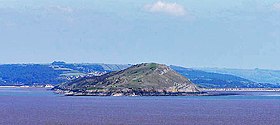Brean Down
| Brean Down | |
|---|---|

Brean Down from Steep Holm
|
|
| Highest point | |
| Elevation | 97 m (318 ft) |
| Prominence | 91 m (299 ft) |
| Coordinates | 51°19′32″N 3°01′44″W / 51.3256°N 3.0290°WCoordinates: 51°19′32″N 3°01′44″W / 51.3256°N 3.0290°W |
| Geography | |
| Location | Mendip Hills, England |
| OS grid | ST284590 |
| Topo map | OS Landranger 182 |
Brean Down is a promontory off the coast of Somerset, England, standing 318 feet (97 m) high and extending 1.5 miles (2 km) into the Bristol Channel at the eastern end of Bridgwater Bay between Weston-super-Mare and Burnham-on-Sea.
Made of Carboniferous Limestone, it is a continuation of the Mendip Hills. Two further continuations are the small islands of Steep Holm and Flat Holm. The cliffs on the northern and southern flanks of Brean Down have large quantities of fossils laid down in the marine deposits about 320–350 million years ago. The site has been occupied by humans since the late Bronze Age and includes the remains of a Romano-Celtic Temple. At the seaward end is Brean Down Fort which was built in 1865 and then re-armed in the Second World War.
Brean Down is now owned by the National Trust, and is rich in wildlife, history and archaeology. It is a Site of Special Scientific Interest due to both the geology and presence of nationally rare plants including the white rock-rose. It has also been scheduled as an ancient monument.
The Mendip Hills, of which Brean Down forms the most westerly part, are the most southerly Carboniferous Limestone upland in Britain. These rock strata were laid down during the early Carboniferous period, about 320–350 million years ago. Subsequently, much of northwestern Europe underwent continental collision throughout the late Paleozoic era, culminating in the final phases of the Variscan orogeny near the end of the Carboniferous period, 300 million years ago. This tectonic activity produced a complex suite of mountain and hill ranges across what is now southern Ireland, south-western England, Brittany, and elsewhere in western Europe. As a result of the Variscan mountain-building, the Mendip area now comprises at least four anticlinal fold structures, with an east-west trend, each with a core of older Devonian sandstone and Silurian volcanic rocks. West of the main Mendip plateau the Carboniferous Limestone continues in Bleadon Hill and Brean Down, and on the islands of Steep Holm and Flat Holm.
...
Wikipedia
